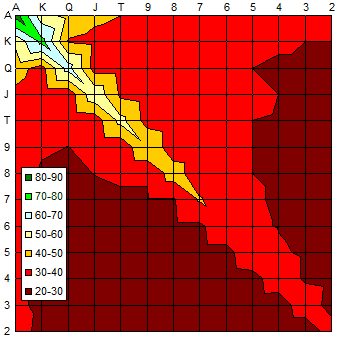fernandovr
Visionary
Platinum Level
I was reading a book and a chapter was about strength index, but in 2 other books and an internet search I did not see anything related to that. I would like to know if anyone knows and could recommend me some book or website for consultation.
Mavca, Carlos. Page 228 - POKER - The essence of texas hold'em (Portuguese)Making a Strength Index (SI)
The "strength index" is established by: J = 11, Q = 12, K = 13, A = 15 (do not forget that the Ace is 15), and the numbers are worth the numbers themselves.
Take the number of your largest card and multiply by 2.
Add the number of your lowest card.
If it is a pair in your hand, add 22.
If it is the same suit, add 2.
The sum is the Strength Index (SI) of your hand.
Using SI
Establish the ratio (R) of the smallest stack with the big blind.
Look at the required SI according to R.
If the value of the SI is equal to or greater than R, put all in (if you are in the SB) or pay (if you are in BB)
R - PUSH(SB) - Call (BB)
1 - 7 - (any)
2 - 21 - 17
3 - 22 - 24
4 - 23 - 26
5 - 24 - 28
6 - 25 - 29
7 - 26 - 30
Last edited:







